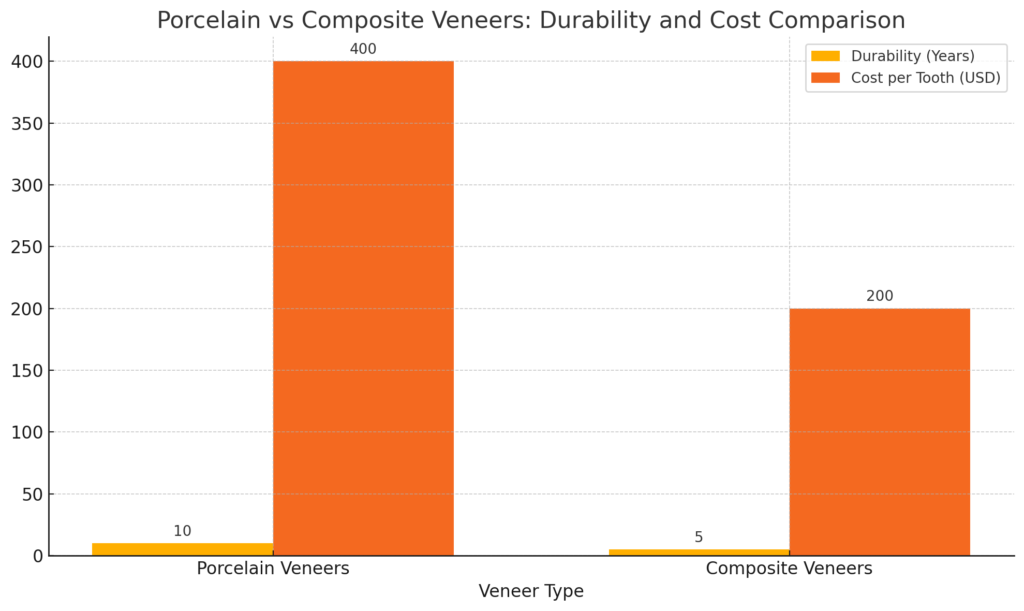When considering veneers for enhancing your smile, two common materials come up: composite and porcelain. Each has its pros and cons, and understanding their differences can help you make an informed decision. In Colombia, both materials are widely used by skilled dentists, but there are key distinctions between the two.
1. Material Composition
- Porcelain Veneers: Made from a durable, high-quality ceramic, porcelain veneers are custom-made in a lab and are designed to mimic the appearance of natural teeth. They are known for their lifelike translucency and smooth texture.
- Composite Veneers: Composed of a resin material, composite veneers are applied directly to the teeth in layers by the dentist. They can be shaped and polished to look natural but lack the same level of translucency as porcelain.
2. Durability and Lifespan
- Porcelain Veneers: Known for their strength, porcelain veneers are more resistant to staining and wear. On average, they can last between 10 to 15 years (or more) with proper care. Their durability is one of their biggest selling points, especially for patients seeking a long-term solution.
- Composite Veneers: While more affordable, composite veneers are less durable than porcelain. They typically last between 5 to 7 years. Composite is more prone to chipping, staining, and needing repairs over time, but repairs are usually easy and quick to perform.

3. Cost Comparison
- Porcelain Veneers: In Colombia, porcelain veneers tend to be more expensive due to the material’s quality, the need for lab work, and their long-lasting nature. They usually cost around $300 to $500 per tooth, significantly less than U.S. prices but still higher than composite.
- Composite Veneers: These are a budget-friendly alternative, costing around $150 to $250 per tooth. Composite veneers are often recommended for patients who need quicker, more affordable treatments or for cases where only minor aesthetic improvements are required.
4. Aesthetic Results
- Porcelain Veneers: These are typically regarded as the gold standard for aesthetics. They are custom-made to match the exact shade, shape, and translucency of natural teeth, providing a natural, almost seamless look. They reflect light similarly to real teeth, making them ideal for patients seeking a flawless smile.
- Composite Veneers: While composite can still produce an attractive result, the material does not match porcelain in terms of sheer beauty or light reflection. Composite veneers may look slightly more opaque and can become dull or discolored more easily over time, especially with frequent consumption of staining foods or drinks.
5. Application Process
- Porcelain Veneers: The process typically involves two appointments. During the first visit, the dentist will remove a small layer of enamel and take an impression of your teeth. This impression is sent to a lab where the veneers are custom-made. On the second visit, the veneers are bonded to your teeth.
- Composite Veneers: Composite veneers can be applied in a single visit. The dentist layers the resin directly onto the teeth and shapes it to the desired form. Once the final shape is achieved, the veneers are polished to look as natural as possible. The quicker application makes composite a popular choice for patients who want immediate results.
6. Stain Resistance
- Porcelain Veneers: Porcelain is naturally stain-resistant, which means your veneers will retain their color over time, even if you consume coffee, red wine, or other staining substances.
- Composite Veneers: Composite resin, however, is more susceptible to staining. While it can be polished to look great initially, the material tends to discolor with regular exposure to staining foods or smoking. Regular polishing by a dentist can help, but the veneers will eventually need replacement.
7. Maintenance
- Porcelain Veneers: These veneers require minimal maintenance beyond regular brushing, flossing, and dental checkups. Given their strength and resistance to wear, they are low-maintenance over the years.
- Composite Veneers: While still easy to maintain, composite veneers require more frequent touch-ups or polishing. Due to their tendency to chip or stain, they may require repairs sooner than porcelain veneers.
8. Good Candidates for Each Option
- Porcelain Veneers: Ideal for individuals looking for a long-term, aesthetic solution. If you want the most natural appearance and don’t mind paying a little more upfront, porcelain is the better choice. They are also recommended for patients with more significant cosmetic issues, such as severe discoloration, cracks, or gaps between teeth.
- Composite Veneers: A good option for patients who want an affordable, quick fix. Composite is perfect for minor cosmetic improvements, like small chips, gaps, or discoloration, and can also be a temporary option for those planning to switch to porcelain later.
9. Examples and Comparisons
- Example 1: Maria, a dental tourist in Colombia, chooses porcelain veneers for a full smile makeover. She needs 8 veneers, which would cost her nearly $20,000 in the U.S. In Medellín, she pays around $3,600 for the same high-quality treatment. The porcelain lasts over a decade, and her new smile looks stunning and natural.
- Example 2: Daniel opts for composite veneers to fix minor chips on his front teeth. At just $400 for two veneers, the procedure is done in a single visit. While they may need replacement in 5 years, it’s a budget-friendly solution for immediate aesthetic concerns.
Conclusion: Which is Right for You?
In summary, the choice between composite and porcelain veneers depends on your budget, aesthetic goals, and how long you want the veneers to last. Porcelain veneers offer superior durability and a more natural appearance, making them the best choice for long-term cosmetic dental solutions. On the other hand, composite veneers provide an affordable, quick fix for those seeking more minor improvements or a temporary solution. Both materials are widely available in Colombia at a fraction of the cost compared to other countries, making dental tourism an excellent option for patients seeking quality care on a budget.





